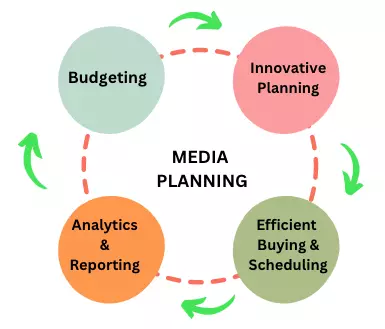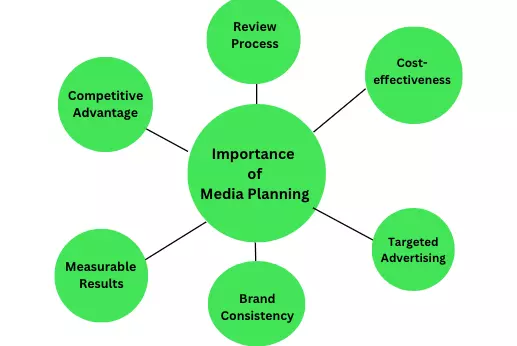Media Planning
Definition
Media planning strategically selects and optimises media channels to deliver advertising messages to a target audience.
Description
Media planning is a strategic process that involves identifying and analysing the target audience, determining the advertising objectives, selecting the most influential media channels, and optimising the media mix to deliver the advertising message to the target audience.

The process involves setting a budget, determining the reach and frequency of the advertising, and evaluating the campaign’s effectiveness. The goal of media planning is to maximise the impact of advertising by reaching the right audience with the right message at the right time and place. Media planning strategically selects and optimises media channels to deliver advertising messages to a target audience.
Importance of Media Planning
Media planning determines the most effective way to reach a target audience through various media channels, such as TV, radio, print, digital, and outdoor. It is a crucial aspect of the advertising and marketing industry and can significantly impact a campaign’s success. Here are some key reasons why media planning is important:

- Cost-effectiveness: Media planning helps to ensure that advertising resources are allocated efficiently, maximising the effectiveness of the advertising spend. By carefully selecting the most appropriate media channels and optimising the timing and frequency of advertising, media planners can achieve better results with fewer resources.
- Targeted advertising: Media planning allows advertisers to reach their target audience more effectively. By identifying the target audience’s demographics, psychographics, and media consumption habits, media planners can select the most appropriate media channels and develop messaging that resonates with the audience.
- Brand consistency: Media planning helps to ensure that a brand’s messaging is consistent across all media channels. This consistency helps to build brand recognition and reinforces the brand’s positioning in the market.
- Measurable results: Media planning enables advertisers to track the effectiveness of their advertising campaigns and make data-driven decisions. By measuring key performance indicators such as reach, frequency, and engagement, advertisers can adjust their media plans to optimise results.
- Competitive advantage: Media planning can give advertisers a competitive advantage by helping them stand out. By selecting the most influential media channels and developing messaging that resonates with the target audience, advertisers can differentiate themselves from their competitors and win market share.
How to start with Media Planning?
Starting with media planning can seem overwhelming, but it is manageable if broken down into smaller steps. Here are some steps you can take to get started with media planning:
- Define your advertising objectives: The first step in media planning is to clearly define your advertising objectives. What do you want to achieve through advertising? Is it to increase brand awareness, generate leads, drive sales, or something else? Your advertising objectives will help to guide your media planning decisions.
- Identify your target audience: To develop an effective media plan, you must identify your target audience. Who are they? What are their demographics, psychographics, and media consumption habits? By understanding your target audience, you can select the most effective media channels to reach them.
- Determine your budget: Your advertising budget will determine the media channels you can afford to use and the frequency and timing of your advertising. You must determine how much you can spend and allocate your budget to the most influential media channels.
- Research media channels: Once you have identified your target audience and budget, you need to research the media channels that are most effective for reaching your target audience. Consider factors such as reach, frequency, cost, and effectiveness when evaluating media channels.
- Develop a media plan: Based on your research, you can develop a media plan that outlines the media channels, timing, and frequency of your advertising. Your media plan should be aligned with your advertising objectives, target audience, and budget.
- Execute and monitor your media plan: Once you have developed it, you must execute it and monitor its effectiveness. Track key performance indicators such as reach, frequency, engagement, and conversion rates, and adjust your media plan as needed.
Future Technology of Media Planning
The future of media planning is likely to be shaped by several emerging technologies. Here are some technologies that are likely to have a significant impact on a lot of media planning:
- Artificial Intelligence (AI): AI has the potential to revolutionise media planning by automating many of the tasks currently performed by media planners. For example, AI can analyse audience data, predict audience behaviour, and optimise media plans in real time. This can improve the efficiency and effectiveness of media planning and reduce the time and resources required to develop a media plan.
- Big Data: The proliferation of data from various sources, including social media, mobile devices, and IoT devices, provides media planners with a wealth of information about their target audience. Big data analytics can extract insights from this data and inform media planning decisions. Media planners can develop more targeted and effective media plans by analysing consumer behaviour and media consumption patterns.
- Augmented Reality (AR) and Virtual Reality (VR): AR and VR are emerging technologies that have the potential to create new opportunities for media planning. For example, AR and VR can create immersive advertising experiences that engage audiences and drive brand awareness. Media planners can use these technologies to create unique and interactive media experiences tailored to their target audience’s needs and preferences.
- Programmatic Advertising: Programmatic advertising is a technology-driven approach to media buying that uses algorithms to automate buying and selling ad inventory. This technology can optimise media plans in real-time based on audience data and performance metrics. By automating media buying and optimising media plans, programmatic advertising can reduce costs and improve the effectiveness of media campaigns.
Things to care of Media Planning
Media planning involves several important considerations to ensure that a campaign is successful. Here are some things to take care of when developing a media plan:
- Understand your audience: Before you begin developing your media plan, it’s essential to understand your target audience. Identify their demographics, psychographics, and media consumption habits to determine the most influential media channels to reach them.
- Define your objectives: Clearly define your advertising objectives before developing your media plan. What do you want to achieve through advertising? Is it to increase brand awareness, generate leads, drive sales, or something else? Your advertising objectives will help guide your media planning decisions.
- Set a realistic budget: Determine how much you can spend and allocate your budget to the most influential media channels. A realistic budget will help you reach your target audience and achieve your advertising objectives.
- Consider the timing: Timing is crucial when it comes to media planning. Determine the optimal time to launch your campaign based on your target audience’s behaviour and the industry’s seasonality.
- Choose the proper media channels: Select the most influential media channels based on your target audience’s media consumption habits, reach, cost, and effectiveness. Consider traditional and digital media channels to ensure you get your audience through multiple touchpoints.
- Optimise your media plan: Continuously monitor and analyse your media plan’s performance to make informed decisions about optimising your campaign. Make adjustments to your media plan as needed to ensure that it remains effective.
- Measure the results: Track key performance indicators, such as reach, frequency, engagement, and conversion rates, to evaluate your campaign’s success. Use this data to inform future media planning decisions and optimise future campaigns.
Example:
Assume that ANC is an energy drink making company. The target audience for the brand will be 18-30 years old people who lead an active lifestyle. The objective of the brand was to increase brand awareness and drive sales. The budget for the campaign was Rs. $500,000.
Timing: Launching in May to coincide with the start of summer and the increased demand for energy drinks during the warmer months.
Media Channels:
- Digital Advertising: Use a combination of display, search, and video ads on platforms such as Google Ads and YouTube to reach the target audience and promote the benefits and unique features of ANC Energy Drink. Allocate $150,000 for digital advertising.
- Influencer Marketing: Partner with relevant influencers on social media platforms such as Instagram and TikTok to promote ANC Energy Drink and reach a wider audience. Allocate $100,000 for influencer marketing.
- Out-of-Home Advertising: Use billboards and bus shelters in high-traffic areas such as college campuses, gyms, and busy downtown areas to raise brand awareness and drive sales. Allocate $100,000 for out-of-home advertising.
- Event Sponsorship: Sponsor events such as music festivals, sports, and college events to promote ANC
- Energy Drink and increase brand awareness. Allocate $100,000 for event sponsorship.
- Point-of-Sale Advertising: Use in-store displays and signage in convenience stores and grocery stores to promote ANC
- Energy Drinks and encourage impulse purchases. Allocate $50,000 for point-of-sale advertising.
- Public Relations: Use public relations strategies such as press releases, media interviews, and product reviews to generate buzz and media coverage for ANC Energy Drink. Allocate $50,000 for public relations.
FAQs
What is media planning?
Media planning is selecting and scheduling media channels to reach a target audience with advertising messages.
Why is media planning important?
Media planning is important because it helps ensure that advertising messages reach the right audience, through the most effective channels, at the right time and within budget.
What factors are considered when developing a media plan?
Factors considered when developing a media plan include target audience demographics and psychographics, advertising objectives, budget, timing, media channels, and campaign performance metrics.
What are some common media channels used in media planning?
Common media channels used in media planning include television, radio, print, digital media (e.g., display ads, search ads, social media advertising), out-of-home (e.g., billboards, bus shelters), and experiential marketing (e.g., events, activations).
How do you measure the success of a media plan?
The success of a media plan can be measured by tracking key performance indicators (KPIs) such as reach, frequency, engagement, conversions, and return on investment (ROI).
How can you optimise a media plan?
A media plan can be optimised by continuously monitoring and analysing campaign performance data and making informed decisions about adjusting media channels, targeting, messaging, and timing.
What role does technology play in media planning?
Technology plays a significant role in media planning by providing tools and platforms for audience targeting, media buying, and campaign optimization. Machine learning and AI technologies are also increasingly used in media planning to optimise media spend and improve campaign performance.





We would love to have your opinion.